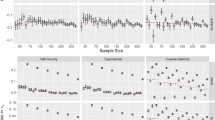Summary
A one-way ANOVA structure is imposed on the item difficulty and the item discrimination parameter of a two-parameter hierarchical IRT model for item effects. Bayesian estimation of the model is illustrated for the Metropolis-Hastings within Gibbs and the data augmented Gibbs procedure. The posterior of the hierarchical IRT model is explored with respect to the location of parameters and the uncertainty of these parameter estimates. The posterior correlations among parameters are shown to be due to trade-off effects among parameters either on the same parameter scales or on different parameter scales.



Similar content being viewed by others
References
Albert, J. H. (1992). Bayesian estimation of normal ogive item response curves using Gibbs sampling. Journal of Educational Statistics, 17, 251–269
Baker, F. B. (1998). An investigation of the item parameter recovery characteristics of a Gibbs sampling procedure. Applied Psychological Measurement, 22, 153–169.
Bradlow, E. T., Wainer, H., & Wang, X. (1999). A Bayesian random effects model for testlets. Psychometrika, 64, 153–168.
Chib, S., & Greenberg, E. (1995). Understanding the Metropolis-Hastings Algorithm. The American Statistician, 49, 327–335.
De Boeck, P., Daems, F., Meulders, M., & Rymenams, R. (1997). Ontwikkeling van een toets voor de eindtermen begrijpend lezen [Construction of a test for the educational targets of reading comprehension]. Leuven/Antwerp (Belgium): University of Leuven/University of Antwerp.
Embretson, S. E. (1998). A cognitive design system approach to generation valid tests: Application to abstract reasoning. Psychological Methods, 3, 380–396.
Gelman, A., Carlin, J. B., Stern, H. S., & Rubin, D. B. (1995). Bayesian Data Analysis. London: Chapman & Hall.
Gelman, A., Roberts, G. O., & Gilks, W. R. (1996). Efficient Metropolis jumping rules. In J. M. Bernardo, J. O. Berger, A. P. Dawid, & A. F. M. Smith (Eds.), Bayesian Statistics 5: Proceedings of the Fifth Valencia International Meeting (pp. 599–608). New York: Oxford.
Gelman, A., & Rubin, D. B. (1992). Inference from iterative simulation using multiple sequences (with discussion). Statistical Science, 7, 457–511.
Gilks, W., Richardson, S. & Spiegelhalter, D. (eds.) (1996). Markov Chain Monte Carlo in practice. New York: Chapman & Hall.
Janssen, R., Tuerlinckx, F., Meulders, M. & De Boeck, P. (in press). A hierarchical IRT model for criterion-referenced measurement. Journal of Educational and Behavioral Statistics.
Kass, R. E., Carlin, B. P., Gelman, A., & Neal, R. N. (1997). Markov chain Monte Carlo in practice: a roundtable discussion. The American Statistician, 52, 93–100.
Lord, F. M. (1975). The’ ability’ scale in item characteristic curve theory. Psychometrika, 40, 205–217.
Lord, F. M., & Novick, M. R. (1968). Statistical theories of mental test scores. Reading: Addison-Wesley.
Patz, R. J. & Junker, B. W. (1999). A straightforward approach to Markov chain Monte Carlo methods for item response models. Journal of Educational and Behavioral Statistics, 24, 146–178.
Rasch, G. (1960). Probabilistic models for some intelligence and attainment tests. Copenhagen: The Danish Institute of Educational Research. (Expanded edition, 1980. Chicago: The University of Chicago Press.)
Spiegelhalter, D. J., Best, N. G., Gilks, W. R., & Inskip, H. (1996). Hepatitis B: a case study in MCMC methods. In W. R. Gilks, S. Richardson, & D. J. Spiegelhalter (Eds.). Markov chain Monte Carlo in practice (pp. 21–43). New York: Chapman & Hall.
Stocking, M. L. (1989). Empirical estimation errors in item response theory as a function of test properties (Research Report 89-5). Educational Testing Service, Princeton, NJ.
Tanner, M. A. (1996). Tools for statistical inference: Methods for the exploration of posterior distributions and likelihood functions(3rd ed.). New York: Springer.
van der Linden, W. J., & Hambleton, R. K. (Eds.) (1997). Handbook of modern item response theory. New York: Springer.
Wingersky, M. S. & Lord, F. M. (1984). An investigation of methods for reducing sampling error in certain IRT procedures. Applied Psychological Methods, 8, 347–364.
Author information
Authors and Affiliations
Additional information
We thank the editor and two referees for helpful comments. The first author is a Postdoctoral Fellow of the Fund for Scientific Research — Flanders (Belgium). The construction of the test used in the example was funded by the OBPWO grant 93.05 of the Ministry of the Flemish Community, Department of Education, awarded to Paul De Boeck and Frans Daems.
Rights and permissions
About this article
Cite this article
Janssen, R., De Boeck, P. Exploring the posterior of a hierarchical IRT model for item effects. Computational Statistics 15, 421–442 (2000). https://doi.org/10.1007/PL00022714
Published:
Issue Date:
DOI: https://doi.org/10.1007/PL00022714




